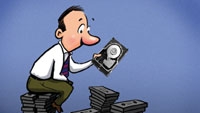MXF is off the starting blocks
At a recent symposium on MXF developments in broadcast operations, I heard how those who have persevered with the format are now beginning to reap the benefits, despite it's long gestation period of about four years. The initial problems have led many to dismiss it as unworkable. There are many evangelists who have overcome the problems, but it is apparent that the broadcast community does not yet believe MXF can be deployed successfully.

The development of MXF illustrates many of the problems of standards development. Broadcast manufacturers want competitive advantages through unique technology and through speed to market. Broadcasters want to build a best-of-breed solution with interoperable technology through agreed standards. Because manufacturers cannot ignore the needs of their customers, we inevitably edge toward standards; it just takes a long time.
There is a constant drive to move from videotape to files, but such radical changes in technology have to be made without affecting transmissions. The move from a proven workflow to an untried workflow has to be taken with great care. As engineers, we may welcome change to new technology, but television is a business that must remain on-air, no matter what. New technology must always be treated with a measure of caution, with the claimed benefits proven before the revenue stream can be trusted to a new platform.
Skeptics may question the need to change, but the broadcasting business does not exist in isolation. The telcos and Internet corporations that are fast moving into the entertainment space have no attachment to conventional broadcast technology. They use whatever gets the job done for the least amount of money — and that tends to be racks of computer servers.
At the MXF symposium, a scientist from BBC Research described a test system that the company had built from commodity IT products. The system could shoot a multicamera production straight to a file server. OK, the director wisely used videotape as the primary storage medium to protect the production against technical glitches, but the experiment proved that it can be done. Some of this year's new cameras are designed to do just that — shoot straight to disk over Ethernet.
Yet I still sense great mistrust in “tapeless” production. Is this just a rerun of the migration from 35mm to electronic production? I can understand a natural and healthy disregard for the new when the job has to be finished reliably and according to schedule.
Film and videotape have many advantages, especially for acquisition. The best approach is to use the appropriate tool for the job, and fast-paced multichannel and multiformat television stands to gain much from melding new and existing technologies in the quest for more efficient processes.
Get the TV Tech Newsletter
The professional video industry's #1 source for news, trends and product and tech information. Sign up below.
I have met production folks who are wary of technology because they've had a server crash on them or a disk fail during a RAID rebuild. Broadcast engineers must reassure these folks and convince them to approach new projects with an open mind and not to write off the new technology. Not only can it lower costs and improve efficiency, but new technology can usher in a new way of making programs, with the nonlinear editor being a great example.
Some folks embrace new technology; some have yet to be convinced. We must explain.
Send comments to:editor@broadcastengineeringworld.com
